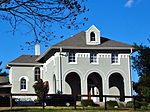Hartwell B. Hyde House
The Hartwell B. Hyde House, also known as Solitude, is a property in Triune, Tennessee that was listed on the National Register of Historic Places (NRHP) in 1988.Hartwell Hyde was an early settler of the Triune area. He and William Jordan arrived in 1810; Jordan's log home is the location of the Newton Jordan House, also NRHP-listed.: 17 The Hyde House was an early plantation homes and had a flour mill and a cotton gin on the property.: 18 The Hyde plantation, with 900 acres, when owned by Mrs. E.B. Hyde, was one of a number of "productive and prosperous" antebellum plantations in the county. : 27 The Hyde House includes Double pen, dog trot, and Italianate architecture. When listed the property included two contributing buildings on an area of 1.1 acres (0.45 ha).
Excerpt from the Wikipedia article Hartwell B. Hyde House (License: CC BY-SA 3.0, Authors).Hartwell B. Hyde House
Murfreesboro Road,
Geographical coordinates (GPS) Address Nearby Places Show on map
Geographical coordinates (GPS)
| Latitude | Longitude |
|---|---|
| N 35.855 ° | E -86.6325 ° |
Address
Lightning Bug Golf Course
Murfreesboro Road
Tennessee, United States
Open on Google Maps



